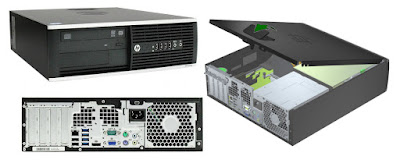The PC part of SDR receiver, a cheap solution

In the development of HF103 rc1 I used a dedicated PC and selected on Amazon an HP Elite 8300 SFF Small Form Factor Business Desktop Computer, Intel Quad-Core i7-3770 up to 3.9Ghz CPU, 8GB RAM, 256GB SSD , DVD, USB 3.0 , Windows 10 Professional (Renewed). It is a recycled PC ! I liked the SFF cover design as it allows you to open and close it very easily. This type of PC is used by Gamers who add an LP graphics card, I used it as it arrived without adding any card. Here a video shows the internals . I had no need to change the fans. It has the HP logo! I’ve been fond of HP since when I met HP instruments and documentation during my working days. See HP Origins - Hewlett Packard Documentary … my subconscious appreciates an SDR with HP logo... Minor mechanical defects may be there. I had to adjust the cover handle mechanism with my unit. I increased the ram to 16 GB as I had the memory sticks in my drawer and added a 1TB HDD to increase data storage space. After installing the Wi...

